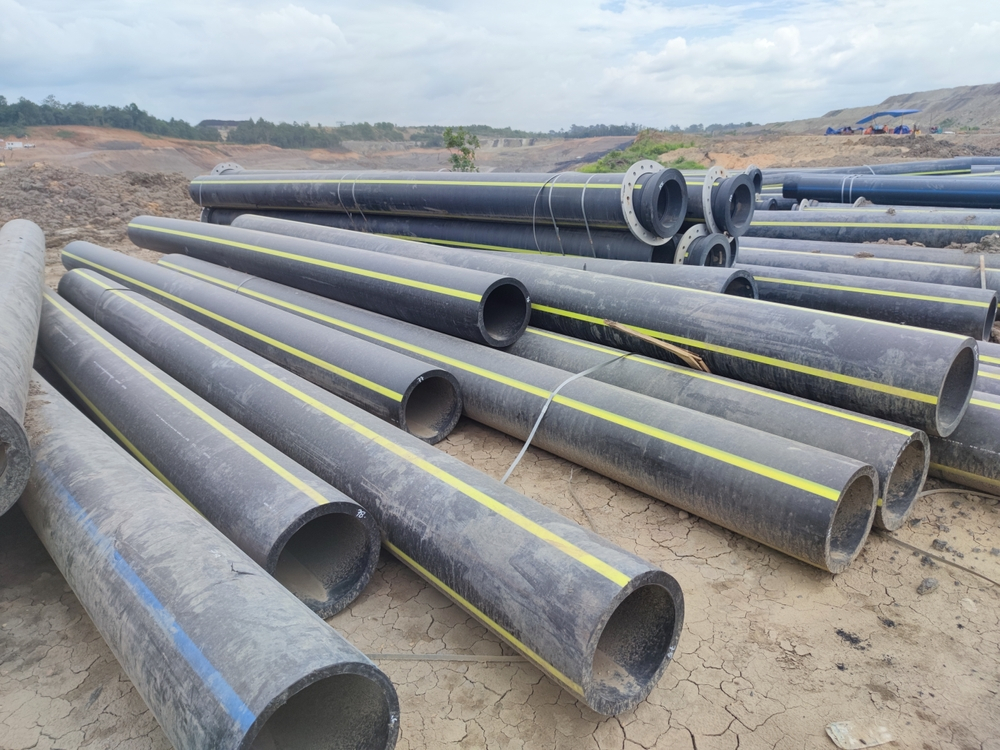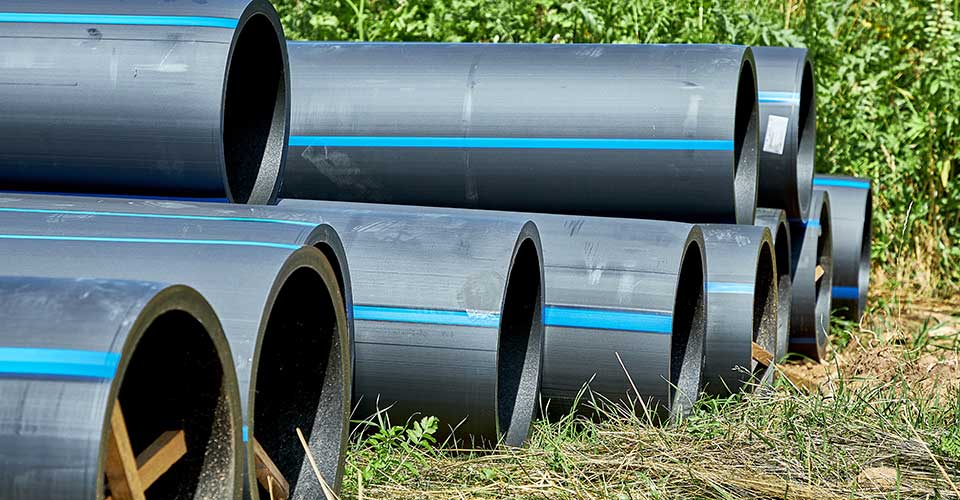Why Partnering with Pipe Supplier American Plastics Midland Ensures Timely Supply
Wiki Article
Check Out the Manufacturing Process Behind High-Quality HDPE Pipeline and Its Applications
The manufacturing process of top notch HDPE pipelines is complex and methodical. It begins with the selection of raw materials that boost efficiency. Following this, ethylene undergoes polymerization to form resin, which is after that shaped via extrusion. Quality assurance is critical, guaranteeing that the final product fulfills rigid requirements. Nevertheless, the journey of HDPE pipes does not end with production. Their applications across different markets reveal a broader value worth checking out.Understanding HDPE: Features and Advantages

High-density polyethylene (HDPE) is a versatile thermoplastic understood for its sturdiness and resistance to various ecological elements. This material shows outstanding tensile toughness, making it appropriate for requiring applications. Its low-density framework contributes to a lightweight item, assisting in convenience of handling and installment. HDPE also showcases impressive resistance to chemicals, which reduces deterioration when exposed to rough compounds.
The material's reduced wetness absorption additionally enhances its durability, making it perfect for usage in pipelines and storage tanks. Furthermore, HDPE is resistant to ultraviolet (UV) radiation, ensuring that products keep their stability also when revealed to sunlight. Additionally, its adaptability permits the production of intricate shapes without jeopardizing stamina. The eco-friendly nature of HDPE, commonly originated from recycled products, adds to its appeal, advertising lasting techniques in production. Overall, these properties and benefits make HDPE a preferred choice for numerous industrial and consumer applications.
Resources Option for HDPE Manufacturing
The selection of basic materials for HDPE manufacturing is vital to validate the end product fulfills the wanted requirements and top quality criteria. High-density polyethylene (HDPE) is largely generated from polymerized ethylene, derived from nonrenewable fuel sources such as natural gas or unrefined oil. The top quality of these feedstocks considerably affects the mechanical and thermal homes of the final HDPE.Additives additionally play a significant role in boosting HDPE's efficiency, consisting of antioxidants, UV stabilizers, and colorants, which enhance toughness and resistance to environmental elements. The selection procedure have to take into consideration not just the chemical structure of the raw materials yet also their processing features to assure effective manufacturing.
Additionally, the sourcing of resources ought to prioritize sustainability and conformity with environmental regulations, as accountable methods are crucial in today's market. Ultimately, careful raw product choice lays the structure for creating top quality HDPE pipes ideal for diverse applications.
The Extrusion Refine: Shaping HDPE Pipe
The extrusion process plays a crucial role in shaping HDPE pipes, beginning with thorough material prep work techniques that guarantee perfect circulation and consistency. Similarly important is the style of the die, which directly affects the last dimensions and surface area quality of the pipeline. Together, these aspects contribute substantially to the efficiency and top quality of HDPE pipe manufacturing.Product Preparation Methods
Reliable production of HDPE pipelines starts with precise material prep work techniques, specifically the extrusion procedure. During this phase, high-density polyethylene material is initial dried to get rid of dampness, ensuring excellent flow features. The resin is then fed into the extruder, where it goes through home heating and melting, transforming right into a viscous state. This heating process is very carefully regulated to keep the material's integrity and performance. The molten HDPE is required via a die, shaping it into a continual pipeline kind. Correct temperature level monitoring throughout extrusion is vital, as it straight impacts the product's residential properties and the final product top quality. When shaped, the HDPE pipeline is cooled and reduced to specified lengths, all set for succeeding handling and applications.Die Layout Importance
Accuracy in die style plays an essential duty in the extrusion process of HDPE pipes. The die functions as the last shaping tool, directly influencing the pipe's measurements, wall surface density, and surface area coating. A properly designed die assurances consistent product flow, minimizing problems such as abnormalities and weak points. The geometry of the die have to be optimized to fit the specific buildings of HDPE, including its thickness and thermal habits during extrusion. In addition, the cooling price of the product as it goes through the die can noticeably affect the pipe's architectural honesty. As a result, buying innovative die modern technology is crucial for producers aiming to generate top notch HDPE pipes that meet industry standards and consumer expectations.Top Quality Control Steps in HDPE Manufacturing
Numerous aspects influence the top quality of HDPE pipe manufacturing, reliable top quality control measures are critical to guarantee consistency and integrity in the last product (hdpe pipe suppliers Midland TX). Secret quality assurance methods consist of strenuous product inspection, verifying that the raw polyethylene satisfies established criteria for purity and density. Throughout the extrusion process, specifications such as temperature level, pressure, and cooling time are very closely checked to preserve dimensional precision and structural honestyIn enhancement, post-production testing is important; makers usually carry out hydrostatic tests to assess the pipeline's stamina and resistance to stress. Visual inspections for surface problems even more improve top quality guarantee. Qualification from pertinent requirements organizations, like ASTM or ISO, supplies an additional layer of reputation. By implementing these thorough quality assurance actions, producers can minimize problems, boost performance, and make sure that the HDPE pipes meet the particular demands of various applications, inevitably bring about customer satisfaction and trust in the item.
Applications of HDPE Pipe Across Industries
HDPE pipes are utilized across numerous sectors as a result of their longevity and adaptability. In water distribution systems, they ensure effective shipment, while in wastewater monitoring, they supply reputable services for waste transport. In addition, agricultural watering networks take advantage of HDPE's resistance to deterioration and versatility, making it a suitable choice for modern-day farming practices.
Water Distribution Systems
A significant number of industries rely upon high-density polyethylene (HDPE) pipes for effective water distribution systems. Known for their sturdiness and resistance to rust, HDPE pipes are widely utilized in municipal water supply networks, agricultural watering, and commercial applications. Their light-weight nature assists in simple handling and installation, reducing labor costs and time. Additionally, Midland TX HDPE Pipe Fittings in Stock HDPE pipelines can fit different pressure degrees, making them suitable for both reduced and high-pressure systems. hdpe pipe suppliers Midland TX. The adaptability of the product permits for seamless combination right into existing infrastructure, reducing the need for comprehensive excavation. In addition, HDPE's resistance to chemical leaching warranties that the water supplied stays risk-free and tidy, making it an excellent option for maintaining the high quality of potable water throughout various sectorsWastewater Monitoring Solutions
Reliable water distribution systems also pave the way for ingenious wastewater administration remedies, where high-density polyethylene (HDPE) pipelines play a significant role. Renowned for their sturdiness and resistance to rust, HDPE pipelines are suitable for transferring wastewater in numerous setups. Their adaptability enables easy installment in complex atmospheres, minimizing the need for comprehensive excavation. Additionally, HDPE's smooth interior surface area decreases friction, enhancing flow rates and efficiency. These pipelines are likewise immune to chemical leaching, making sure that pollutants do not compromise the surrounding environment. Industries, municipalities, and therapy centers significantly count on HDPE pipelines for their reliability and longevity, making them a recommended option for contemporary wastewater management systems. This versatility highlights the vital importance of HDPE pipelines throughout various applications.Agricultural Watering Networks
Agricultural watering networks benefit substantially from making use of high-density polyethylene (HDPE) pipes, which give effective and reputable water delivery to plants. HDPE pipes are lightweight, making them very easy to carry and install, while their versatility permits different setups in varied terrains. These pipelines demonstrate superb resistance to corrosion, chemicals, and UV radiation, ensuring longevity in extreme farming atmospheres. In addition, their smooth interior surface decreases friction loss, maximizing water flow and minimizing power prices connected with pumping. The durability of HDPE pipelines, often going beyond 50 years, contributes to lower maintenance and substitute expenses. As a result, farmers increasingly count on HDPE pipes to boost irrigation efficiency and advertise sustainable farming techniques, ultimately leading to enhanced plant returns and source conservation.Future Fads in HDPE Pipe Technology
As the need for sustainable and reliable facilities grows, innovations in HDPE pipeline technology are positioned to transform various markets. Emerging fads consist of the combination of smart innovations, such as sensors and IoT capabilities, which facilitate real-time tracking of pipe problems, decreasing upkeep costs and protecting against leaks. Furthermore, the development of sophisticated manufacturing methods, such as 3D printing, is making it possible for the production of facility, personalized pipeline styles that satisfy particular job needs.The focus on recycling and circular economic climate techniques is driving the innovation of HDPE pipes made from recycled products, improving sustainability. Boosted jointing methods, such as electro-fusion and mechanical fittings, are likewise enhancing installment performance and integrity. The expanding focus on ecological guidelines is pushing producers to take on greener manufacturing procedures, ensuring that HDPE pipes not only satisfy market requirements however likewise foster a more lasting future for framework growth.
Regularly Asked Inquiries
Just How Does HDPE Compare to Other Plastic Materials?
HDPE outmatches several various other plastic products concerning sturdiness, chemical resistance, and adaptability. Its low thickness and high tensile toughness make it ideal for various applications, often surpassing alternatives in both efficiency and durability.What Are the Ecological Impacts of HDPE Production?
The environmental influences of HDPE manufacturing consist of greenhouse gas exhausts, energy consumption, and potential air pollution from producing processes. Additionally, inappropriate disposal can lead to soil and water contamination, increasing worries regarding lasting eco-friendly effects.Can HDPE Pipeline Be Recycled?
Yes, HDPE pipes can be reused. Numerous facilities accept made use of HDPE for processing, changing it into new products. This reusing adds to sustainability efforts, decreasing plastic waste while conserving resources and power in the production cycle.What Is the Lifespan of HDPE Pipes?

Just How Do Temperature Variants Impact HDPE Pipeline Efficiency?
Temperature level variations significantly affect HDPE pipe performance, affecting adaptability and strength. Heats can result in softening, while reduced temperature levels may create brittleness, ultimately affecting the pipeline's toughness and viability for different applications in diverse atmospheres.Report this wiki page